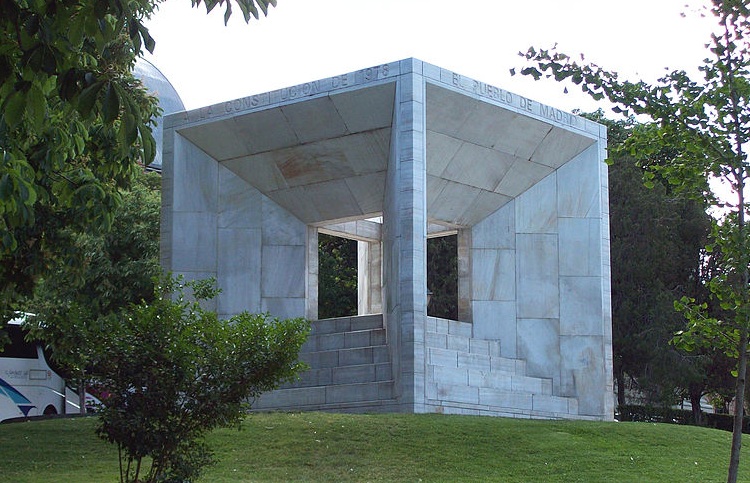Antonio Alonso Marcos
Professor at San Pablo CEU University
Many people think that the iconic photo of a Soviet soldier placing the flag on top of the Reichstag building, half-destroyed by the attacks to take over Berlin, is of a nameless, faceless soldier. Nothing could be further from the truth.
A little-known episode
This year marks the 100th anniversary of the birth of Rakhimzhan Koshkarbayev, the Kazakh officer at the centre of this story. Berlin was not liberated by the Americans, but by the Red Army, which is why Koshkarbayev was there.
For decades, people were led to believe that it was two other Soviet soldiers – Russian Mikhail Yegorov and Georgian Meliton Kantaria – who had accomplished this feat. This is yet another case of “fake history” that the investigation uncovers, such as the real culprits behind the Katyn massacre (1940) or the real motives behind von Rath’s death (which led to the Kristallnacht pogrom in 1938).
On 30 April 2021, the Russian Ministry of Defence posted on its Instagram account an explanation of why this has been understood to be the case for so long. According to the war reports and Koshkarbayev’s memoirs, Major Vasily Davidov asked him to place the red flag on top of the Reichstag building. So Lieutenant Rakhimzhan Koshkarbayev and Private Grigory Bulatov of the 674th Infantry Regiment of the 150th Infantry Division crawled for seven hours among corpses for some 260 metres to the steps of the iconic building, and from there quickly climbed to the first floor, where they placed a “homemade” flag on the façade – nothing like a fancy banner. It was 2.25 p.m. on 30 April 1945.That same night, Yegorov and Kantaria put the flag on top of the building.
However, the famous photo in which photographer Yevgeny Khaldney immortalised the presence of the Victory Flag at the top of the Reichstag was taken days later, on 2 May 1945, when the German army had finally surrendered. It was necessary to reproduce what had gone before, to pose for Khaldelei to take the iconic snapshot. It was Yegorov and Kantaria who put up the flag, even though their colleagues Koshkarbaev and Bulatov had already symbolically taken the building a few days earlier, which gave the Soviet troops high morale.
A discreet centenary for a discreet hero
Rakhimzhan Koshkarbaev was born in the small town of Akmolinsk – or Akmola, the present-day capital of Kazakhstan, Astana – on 19 October 1924. His mother died in 1928, and at the age of 13 he was sent to an orphanage when his father – Koshkarbai Musin, a kolkhoz worker who could not read – was declared an “enemy of the people” and imprisoned during the Great Purge of 1937. At the age of 16, he asked to join the Red Army, which was not granted until he came of age. Already engaged in the Great Patriotic War against the Nazis (1941-45), Koshkarbayev served in a rifle regiment in Kokshetau (Kazakhstan) in August 1942. Shortly afterwards he went to study at the General Infantry School in Tambov, Russia, and in October 1944 he was assigned to the front.
After the war he married and had a daughter – Aliya – and worked on a Soviet farm in Akmola province for the Ministry of Public Services of the Kazakh SSR. In 1967 he was appointed director of the Almaty Hotel, which he ran for almost 20 years. In addition, Rakhimzhan Koshkarbayev was elected three times as a deputy of the Council of People’s Deputies of the Sovetsky district of the city of Almaty. He was also a member of the Presidium of the Kazakh branch of the Soviet War Veterans Committee and the Soviet-German Friendship Society.
During his lifetime he received many awards, especially in Kazakhstan, but also in Germany. He received the Order of the Patriotic War (first degree), the Order of the Military Red Banner and many other orders and medals of the USSR. However, no matter how many requests there were from high-ranking officers of the Soviet Army, including in 1965 the First Secretary of the Central Committee of the Communist Party of Kazakhstan, Dinmukhammed Akhmedovich “Dimash” Kunayev. He was never awarded the title of Hero of the Soviet Union, because his father had been declared an “enemy of the people”, although Musin Koshkarbai was later acquitted and the title was dropped in the 1960s.
In 1980 he received the title of honorary citizen of Tselinograd (“tselini” means “virgin lands”, and Akmola was renamed Akmola in 1961 as the centre of Nikita Khrushchev’s “Virgin Lands” project). One of the Berlin shipyard brigades was named after him. He left his memoirs in two books: “Jenis zhalauy” (“Banner of Victory”, 1978) and Storm (1983). The film director A. Alpiev shot the documentary “The Soldier of Victory” about his life for Kazakhfilm.
He died in Alma Ata on 10 August 1988, when the USSR was beginning to collapse. In 1999 Nursultan Nazarbayev posthumously awarded him the title of Halyk Kaharmany (“people’s hero”). Since 2016 he has had a monument dedicated to his deed on the avenue named after him, very close to the Pyramid of Peace and Reconciliation (designed by Norman Foster).
© All rights reserved





